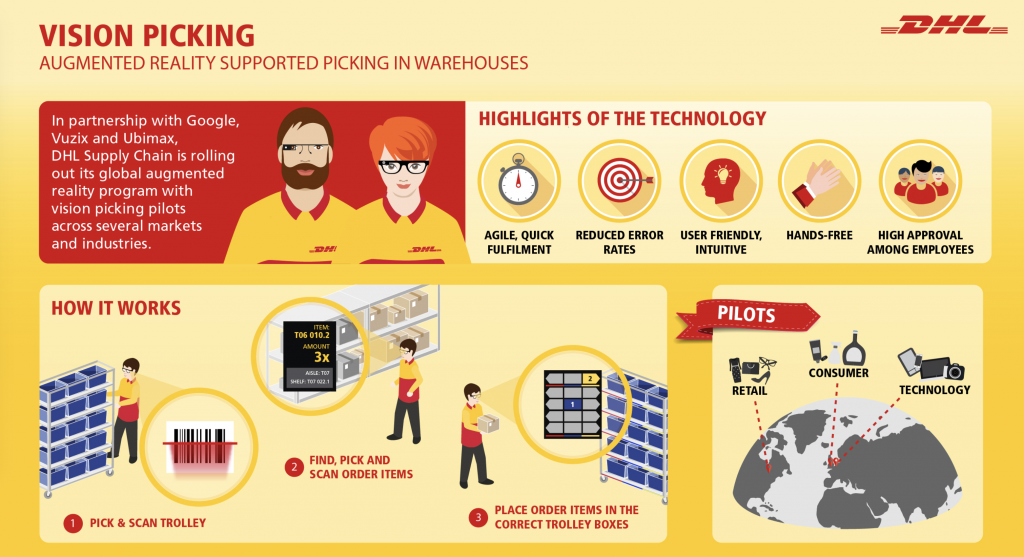Having quick access to vital information is key for prospective and precise planning, as well as operation of tasks. This includes delivery and load optimization, which is critical to providing higher levels of customer service, and better business operations overall.
AR in the logistics industry can truly add value to the areas of warehousing operations, including planning and handling, and even transportation optimization down to the last-mile delivery.
Optimized Picking and Planning in Warehousing Operations
For logistics in warehousing operations, the most advantageous AR solutions are systems that optimize the picking process. Most warehouses in the world still use the pick-by-paper approach, which is both slow and error prone. It also, more often than not, requires temporary workers that have to undergo cost-intensive training to do this job effectively.
There are currently systems by Knapp, SAP, DHL, and Ubimax, who are currently in the late field-test phase of mobile AR systems. These systems not only include the head-mounted displays, but also cameras, a wearable PC, and even battery packs that provide enough power for at least one entire work shift. This vision picking software provides real-time object recognition, barcode reading, indoor navigation, and even seamless integration of information with the management system of the warehouse.

The benefits of using a system like this helps each worker see a digital picking list in their field of vision, and the best route in order to acquire these items. This saves time by providing efficient path planning.
Additionally, using automated barcode scanning capabilities and image recognition software, these systems can check whether the worker has arrived at the right location, and guide the worker to quickly locate the right item on the shelf. The worker can then scan the item, which enables real-time stock updates. This reduces even more time required to train new employees, as well as bridge any language barriers with migrant workers.

Field tests of these AR systems have proved they offer significant productivity improvements in warehousing operations. For example, constant picking validation can decrease errors by as much as 40%. Although today’s picking error rate is very low, even using a pick-by-paper approach — experts estimate a rate of 0.35% — every error must be prevented, because it typically results in high follow-up costs.
Augmented reality is also likely to affect warehouse-planning processes since today’s warehouses are not only used as storage and distribution hubs, they also house a number of value-added services. This can include services such as product assembly, labeling, repacking, and even repair.
This results in having warehouse hubs being redesigned to accommodate to these new services. However, AR can be used to visualize any planned rearrangements in full scale, making it possible to place interactive digital representations of proposed future changes in the present warehouse environment. Planners can test whether measurements of a planned modification will fit in place and model new workflows, and in the future, can allow a warehouse to be used as the testing grounds for warehouse operation planning.
Optimization in Transportation from Pick-Ups to Last-Mile Deliveries
With AR, completeness checks can be more effective, leading to better pick-ups. By quickly glancing at a truck’s load using an AR system that combines scanners and 3D depth sensors, workers can determine the number of pallets, parcels, or even total volume. This measurement would be compared to predefined values, and the results would be displayed accordingly, including detection of any damages.
In international trade services, an AR system can assist in ensuring every shipment complies with the relevant import and export regulations, and that trade documentation has been correctly filled out. AR could even go as far as to scan trade documentation and translating this for the viewer in order to reduce port and storage delays.
Traffic congestion is also a challenge that prevents the seamlessness of many economic processes of the transportation of physical goods. In fact, in Europe alone, it is estimated that traffic congestion costs 1% of gross domestic product (GDP) each year, according to European Commission.
Another important area of application for AR is at the last-mile delivery, which is the final step in the supply chain, and often the most expensive one. Many drivers end up spending a majority of their time locating the correct boxes within their truck for the next delivery. This is all dependent on their memory of the actual loading process.
Using AR, each driver could receive pertinent information about a specific package just by looking at it with their display. This information could include the type of goods, the weight, the delivery address, handling instructions, and even calculate the space requirements in real time, and scan for a feasible empty space in the truck. This would provide a faster and convenient process for the driver at every drop-off.
The Outlook of Augmented Reality in Logistics
Before AR systems can be widely adopted in logistics, we need to overcome a number of challenges including battery life, high investment cost, network performance issues, and privacy. Of course, logistics providers and customers should be aware of the many benefits. We must be ready to take advantage of opportunities as they arise, any of which are currently untapped.
In the near future, AR is very well positioned to deliver some of the future’s most compelling user interface and display technologies, harnessing the potential to fundamentally change how we perceive information and interact with it.




